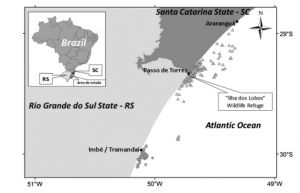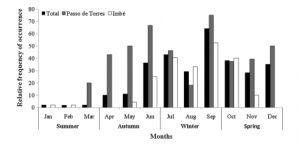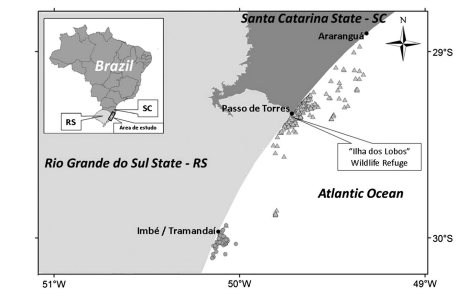Competitive Interactions Between South American Sea Lions and Fishermen in Southern Brazil
By James Keegan, RJD Intern
Often, humans and top predatory carnivores compete for the same resources, even in the marine environment. This conflict occurs where fishing operations of humans and feeding areas of the predators overlap. In South America, fishermen complain of adverse competition from South American sea lions, which interact with all types of fishing gear. South American sea lions can interact with fishing effort either directly or indirectly. They can damage the fish captured by nets or the nets themselves, or they can decrease the relative abundance of local fish, decreasing the fishermen’s yield. Conversely, this competition can adversely affect the sea lions, decreasing their populations or changing their diet composition. Machado et al. 2015 sought to understand the competitive influence between humans and South American sea lions by providing the first detailed characterization of direct interactions between coastal gillnet fishing and the sea lions in Brazil.
Off the coast of southern Brazil, medium-scale gillnet fishing is the predominant fishing activity. Gillnets are vertical panels of netting hanging in the water column which allow fish to pass their heads through the netting, but not their bodies. The net then snags onto the fish’s gills as they try and back out, capturing the fish. Gillnet fishing activity in this region was monitored during three periods: 1992 to 1998, 2003 to 2005, and 2011 to 2012. During the surveys, scientists collected vessel characteristics, fishing area and net location gear type, target species, fishing effort (length of the nets and soak time), number of fishing operations (recovery of the net from the water), fish species captured, and the number of South American sea lions present near a net during a fishing operation.

Study area showing two fishing harbors (Imbé and Passo de Torres) in Southern Brazil. The gray circles represent fishing operations based out of Imbé and the gray triangles represent fishing operations based out of Passo de Torres. (Machado et al. 2015)
Machado et al. 2015 found that South American sea lions interacted with gillnets in 24% of the fishing operations monitored. They also found that interactions increased with increased soak time, and that interactions were significantly affected by the seasons, with more interactions occurring in the winter. Moreover, in 85.3% of the interactions recorded, South American sea lions ate fish caught in the nets. In order to trick or drive the sea lions away, fisherman would resort to tactics like throwing fireworks in the water or putting out decoy nets. Fortunately, no sea lion mortalities occurred during the study due to incidental capture or injury caused by fishermen.

Relative frequency of occurrence of interactions between South American sea lions and coastal gillnet fishing in the two study areas of Imbé and Passo de Torres in southern Brazil during the three study periods (1992-2012). (Machado et al. 2015)
The highest frequency of interactions occurred in autumn and winter. This may be due to the low fish availability during that time, requiring a greater effort from the sea lions to obtain food, which creates a driving force for targeting fishing vessels. However, these interactions seem not to have a great economic impact on fisheries because they do not occur at a high frequency throughout the year, and the amount of fish the South American sea lions consume represents about .8 to 3.5% of the total landed value of the catch (Machado et al. 2015). Nevertheless, South American fishermen have a negative view of the sea lions, saying that they cause a significant economic loss. Moreover, this negative perception will only worsen in the future as fish stocks continue to decrease and competition for this resource increases. In order to alter this perception, a fisheries management system needs to be developed that reduces fishing effort and recovers fish stock. Additionally, by educating fishermen on the real economic impact sea lions have on their production, conflicts between fishermen and sea lions would decrease.
References:
Machado, R., Henrique, P., Benites Moreno, I., Danilewicz, Tavares, M., Alberto Crespo, E., Siciliano, S., Rosa De Oliveira, L. (2015). Operational interactions between South American sea lions and gillnet fishing in southern Brazil. Aquatic Conservation: Marine and Freshwater Ecosystems. doi: 10.1002/aqc.2554




Leave a Reply
Want to join the discussion?Feel free to contribute!